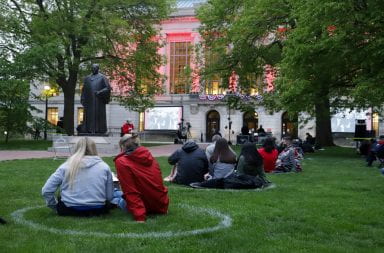Representatives from Central Ohio Transit Authority discussed pending bus stop changes coming to Ohio State during a town hall meeting, but its presentation on a revised number of stop removals only reached a handful of people that the change will affect.
With roughly 100 seats available, only about 15 were filled during a Wednesday presentation in the Round Meeting Room at the Ohio Union.
Service planner for COTA Kristine Marsh led the meeting with a presentation on the bus stop service improvement project, COTA’s proposal to balance efficiency and usability by eliminating several bus stops in Columbus.
The revised proposal for May would be to remove the bus stops at northbound and southbound stops at North High Street and Northwood Avenue, and stops at North High Street and East 17th Avenue.
The new proposal has four stops slated for removal, while the old one had six including stops located at North High Street and E. 15th Avenue.
The initial proposal was revised after public backlash about the proposed E. 15th Avenue eliminations, Marsh said.
“Our goal is to improve the efficiency of our operations which benefits our riders, so our goal is to speed things up as much as possible,” Marsh said.
She explained that the project’s goals were to optimally space bus stops to balance the need for faster in-vehicle travel time and reasonable distances customers would have to walk to the bus stops. They are the “two competing needs that are always at odds with each other,” Marsh said.
Other goals included improving operational efficiency, and on-time performance.
Marsh confirmed that the $13.50 fee students pay each semester will not be raised as a result of any of the planned changes, and that the frequency of buses will not be altered.
COTA took the feedback, which included the preference for the shelter and lighting provided at North High Street and E. 15th Avenue and implemented a revised edition, however, the public still has concerns.
Jean Pitman, an educator for youth programs at the Wexner Center for Arts, attended the meeting and voiced her concerns about how the proposal would work at OSU.
“This is one of the largest universities in the country. We love bus stops. I use the bus every day and there are tons of people getting on it and tons of people getting off. It is a busy area,” Pitman said.
Brian Myers, OSU medical student and chair of OSU and COTA Partnership Advisory Committee, said the feedback has been well received.
“COTA really cares about what everyone at Ohio State thinks … and COTA always has open ears to suggestions, concerns, everything like that,” Myers said.
COTA will notify the public about the final decision in April, and changes will be implemented May 6.
Kelsie Marty, a marketing intern for COTA, said the contract between OSU and COTA began in 1997.
The OSU and COTA Partnership Advisory Committee was created to better the relationship and communication between OSU and COTA, Myers said. He said representatives from OSU’s Student Life and other departments are able to meet regularly and talk with executives from COTA.
Marsh said this town hall meeting was set up to point out the revised proposal and “to seek additional input about that proposal.”


